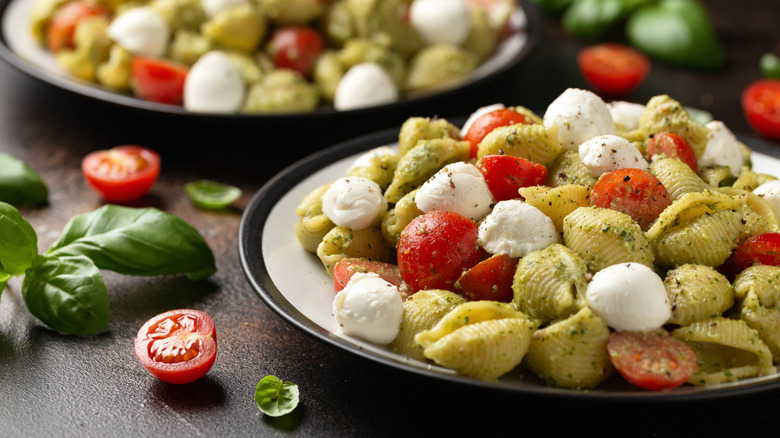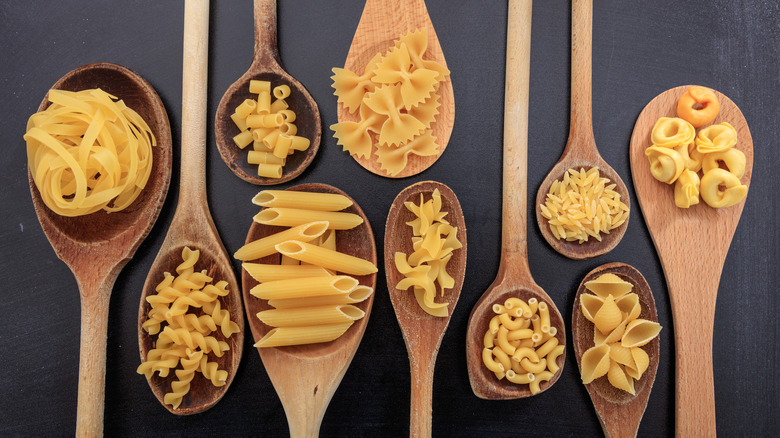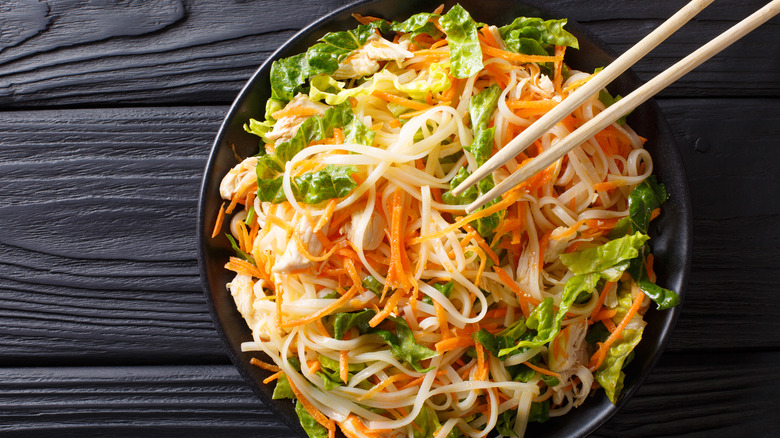For The Best Pasta Salad, Noodle Shape Matters
Everyone and their aunt insists they have the best pasta salad recipe on the block. All manner of mix-ins, dressings, and seasonings can make this humble dish special. However, many are overlooking the most essential ingredient in a pasta salad — the pasta. Choosing the wrong pasta shape is one of the most common pasta salad blunders, and can turn a pasta salad from crowd favorite to a mushy mess.
The secret to pasta salad success is selecting a pasta that offers curves and textures to grip dressing without disintegrating. With this in mind, fusilli, rotini, cavatappi, penne, and farfalle are all strong candidates. But just as salads are loosely defined and can include just about any mix of ingredients with a dressing (just look at deviled egg potato salad), pasta salads can take many forms too. In fact, you might be limiting yourself by sticking to a short list of pasta shapes (more on that later).
Tried-and-true noodle options for pasta salad
The ideal pasta for salad should harmonize with the size and texture of the chopped ingredients to create a satisfying bite. And since what makes pasta salad a salad (beyond being cold) is dressing, the pasta has to hold up well to it, that is rank high in sauceability. In polls that survey for folks' favorite pasta salad bases, tightly wound fusilli often tops the lists, as it holds its shape for visual appeal while also clinging to the dressing. Rotini and cavatappi are also worthy of pasta praise and rank high on such lists. Other options that often get overlooked include macaroni, rotelle, couscous, orzo, and ditalini.
On the other hand, some pasta shapes are less naturally suited to standard pasta salads. Spaghetti, fettuccine, and angel hair, which are often prone to clumping, may not blend neatly with other chopped salad ingredients. Similarly, robust pasta shapes like rigatoni, mostaccioli, and lasagna can take over the pasta salad, failing to mix cohesively. Sturdiness is also an important factor to consider when choosing a shape, and pastas that use alternative flours (such as gluten-free or chickpea) can break down when dressed; although you can avert some mushiness by avoiding overcooking and remembering to rinse your pasta after cooking (unlike you would with a hot pasta dish).
Exploring the wide world of pasta salad ideas
Certain pasta shapes lend themselves easily to most pasta salads, but we believe in being an equal opportunity connoisseur. All pasta shapes are good pasta shapes. If you need evidence, look at regional takes on pasta salad. In North America, variations range from classic rotini with summer vegetables, cheese, and a light vinaigrette, to sweet, creamy Hawaiian macaroni salad.
Across Asia, there are countless cold noodle salads and dishes to enjoy. Take bún thịt nướng, a cold noodle salad that hails from Vietnam and mixes rice noodles, marinated pork, and vegetables to make a balanced and beautiful dish. Or head to Thailand for yum woon sen, a glass noodle salad with ground meat, shrimp, and tomatoes. Korea is also home to delicious cold noodle dishes like bibim guksu (spicy cold noodles) and japchae, a glass noodle stir fry dish that can be eaten hot or cold.
For European-inspired fare, Germany has nudelsalat, a pasta dish made with short pasta, vegetables, cured meat, pickles, and a creamy dressing. Pasta salad is also enjoyed during the summer in Italy, with short-shaped pasta tossed with oil, vinegar, seasonal vegetables, and sometimes cured meats. When it comes to pasta salad, you can draw inspiration from just about anywhere, and although short pasta might yield the most consistent results, you can use any pasta you like.


